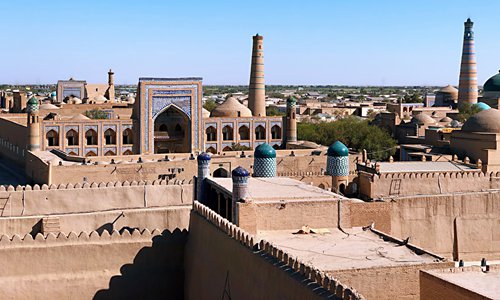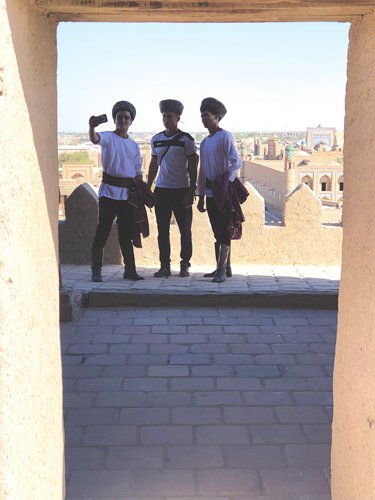HOME >> ARTS
UNESCO heritage site in Uzbekistan to see more Chinese tourism and cooperation
By Xu Liuliu Source:Global Times Published: 2019/10/10 18:18:40

Khiva, Uzbekistan Photo: Xu Liuliu/GT

Tourists take a picture in Khiva. Photo: Xu Liuliu/GT
You can never truly understand how beautiful and glorious Khiva is until you find yourself standing inside the ancient city itself. No words can match its beauty and the ancient wisdom on display in the buildings and planning of this city in central Asia's Uzbekistan. With a seven-day visa-free policy for Chinese travelers coming in 2020, this UNESCO World Heritage site along the ancient Silk Road is expecting to see an increase in both tourists from China and archeology cooperation with the country.Itchan Kala in Khiva
Established around 1,500 years ago in what is today's Xorazm Region, Khiva can be roughly divided into two sections - the new outer town of Dichan Kala, which is formed by a wall of 11 gates, and Itchan Kala, the older inner town, encircled by brick and walls and believed to have been built in the 10th century. Becoming the first site in Uzbekistan to be inscribed on the World Heritage List in 1991, Itchan Kala is well-known around the world for its more than 50 historic monuments and 250 old houses.
Among these are the famous Kalta Minor, a large blue tower in the central city square. The tower was supposed to be a minaret but construction on it ceased upon the death of the Khan and the succeeding Khan didn't complete it. There is also the Djuma Mosque. Although the 10th century mosque was rebuilt in 1788-89, its celebrated hypostyle hall still retains 112 columns taken from the ancient structure.
As an old saying goes among traders who set out on the Silk Road from China's Xi'an (known as Chang'an in ancient times): "I would offer a small bag of gold to set an eye on Khiva."
However, as the centuries have passed, these buildings and structures have suffered damage to various degrees and are currently in need of protection and restoration.
A helping hand from China
To this end, in 2014 China and Uzbeskitan announced they would be working together to restore Itchan Kala. The project, which is set to finish this year, has mainly focused on the Amir Tura Madrasah, the Khasah Murad Mosque and their surrounding buildings. Both of them are located near the north gate, where still a lot of local people reside. The madrasah, an ancient place of learning, was constructed in 1870 by Amir Tura, the brother of Muhammad Rahim-khan II ( 1863-1910).
Yan Ming, an expert from the Chinese Academy of Cultural Heritage, told the Xinhua News Agency that an imperfect drainage system in the area as well as rainfall and wastewater infiltration caused the ground to subside, leading to many cracks to appear in the building, such as one more than 20-centimeter-long crack in one wall.
He noted that the restoration was no simple task as that their principle goal was to restore the cultural relics to their original state as much as possible, which meant that local traditional craftsmanship and materials had to be used for the restoration.
More Chinese visitors
One of the most popular tourist destinations in central Asia, Uzbekistan boasts more than 7,400 cultural heritage items including architecture and food like Uzbek Plov, the best lamb pilaf in central Asia.
Tourism in the country has played an increasingly major role recently, especially after President Shavkat Mirziyoyev signed a new tourism bill into law on July 18. According to a report from The Tashkent Times on July 19, the new law, which includes 45 articles, defines "the main areas of the national policies in the field of tourism. Among them is setting tourism as a strategic sector of the economy, facilitating the development of domestic tourism, attracting investment, enhancing Uzbekistan's image as a country ripe for tourism and stimulating the development of tourist zones and tourist clusters."
In 2018, the country received over 5 million international travelers and the number of visitors for this year is expected to break 6 million.
By September, more than 330,000 Chinese travelers visited the country. Statistics from Chinese travel platform lvmama.com shows an increase of 27.4 percent in orders to travel to Uzbekistan during the first half of this year. The new simplified visa policy is expected to push this number past 500,000 this year.
Different from Samarkand and Bukhara, two cities that are familiar to Chinese as stops along the Silk Road, Khiva is still a rather unfamiliar name for most Chinese, although Xorazm appears in Chinese history books from time to time.
This seems set to change as the city is gaining a larger profile. A local vendor told the Global Times that she has noticed more and more Chinese faces have been appearing in Itchan Kala recently.
Another factor to consider is that China's Belt and Road Initiative strongly connects two countries. More and more locals are becoming connected to China. For instance, some have friends or classmates who are studying or working in China.
A staff member at a Khiva museum showed the Global Times photos that her younger brother took while living and working in Beijing.
Newspaper headline: Gem on the Silk Road
Posted in: CULTURE & LEISURE